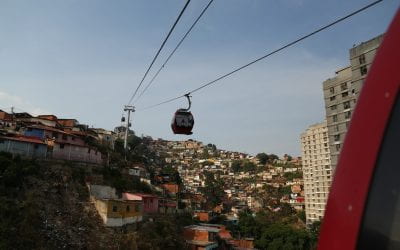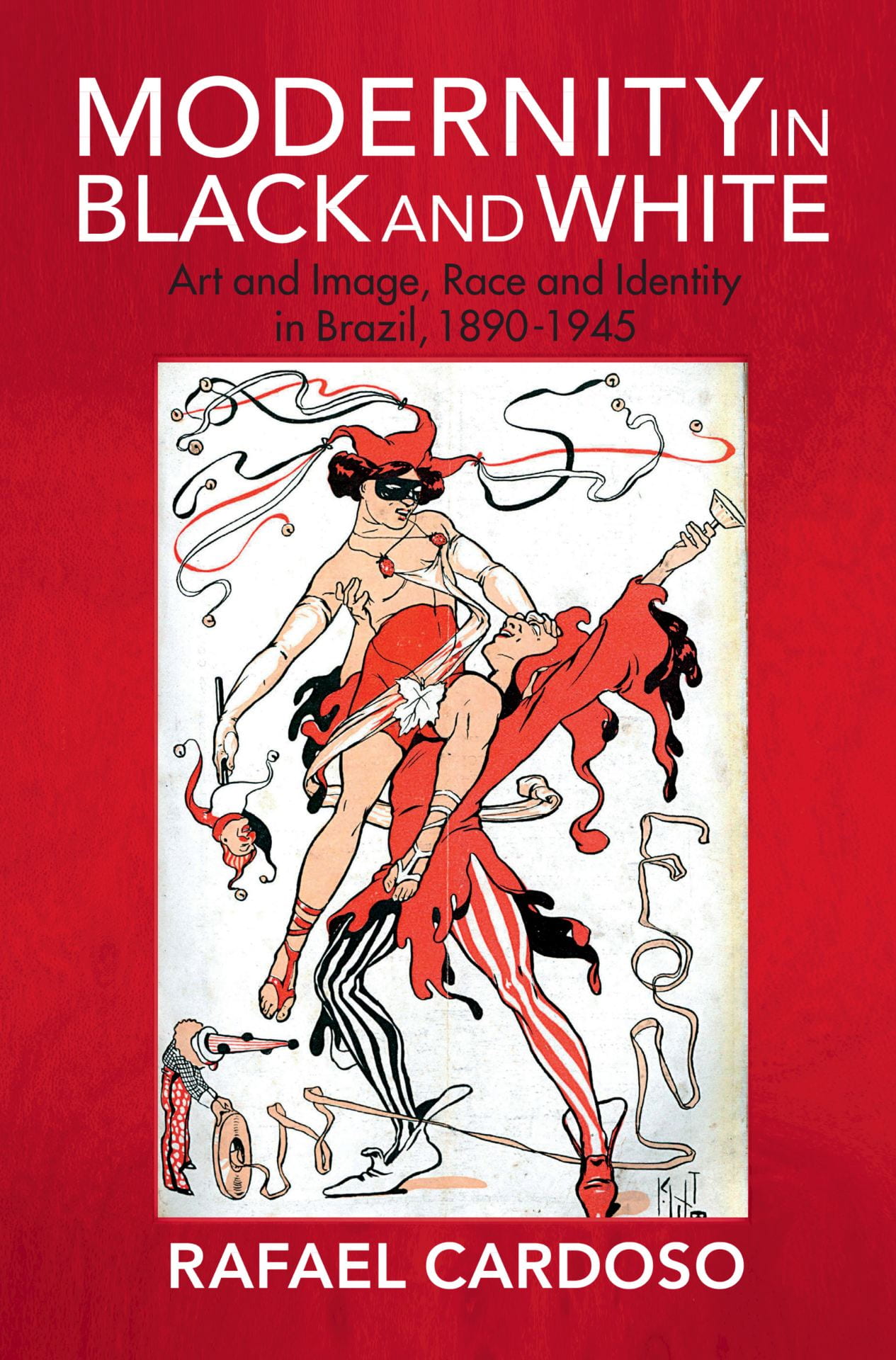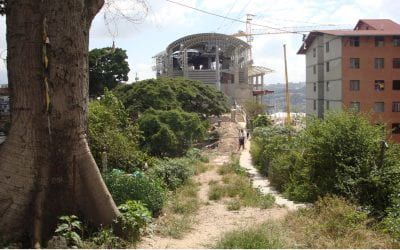From Inroads to Transportation
Bulldozers to Buses in the Ecuadorian Amazon
Early Amazonian trade and transportation generally floated along the vast lower riverine system or was trekked on backs across many rapidly moving headwaters. In the mid- to late- 20th century, the first roads opened, leading largely to resource extraction, not convenient public transportation. Now, across many areas, buses shuttle indigenous citizens to schools and into political life. Such traveling has produced significant changes in indigenous political organization and access to education for both men and women.
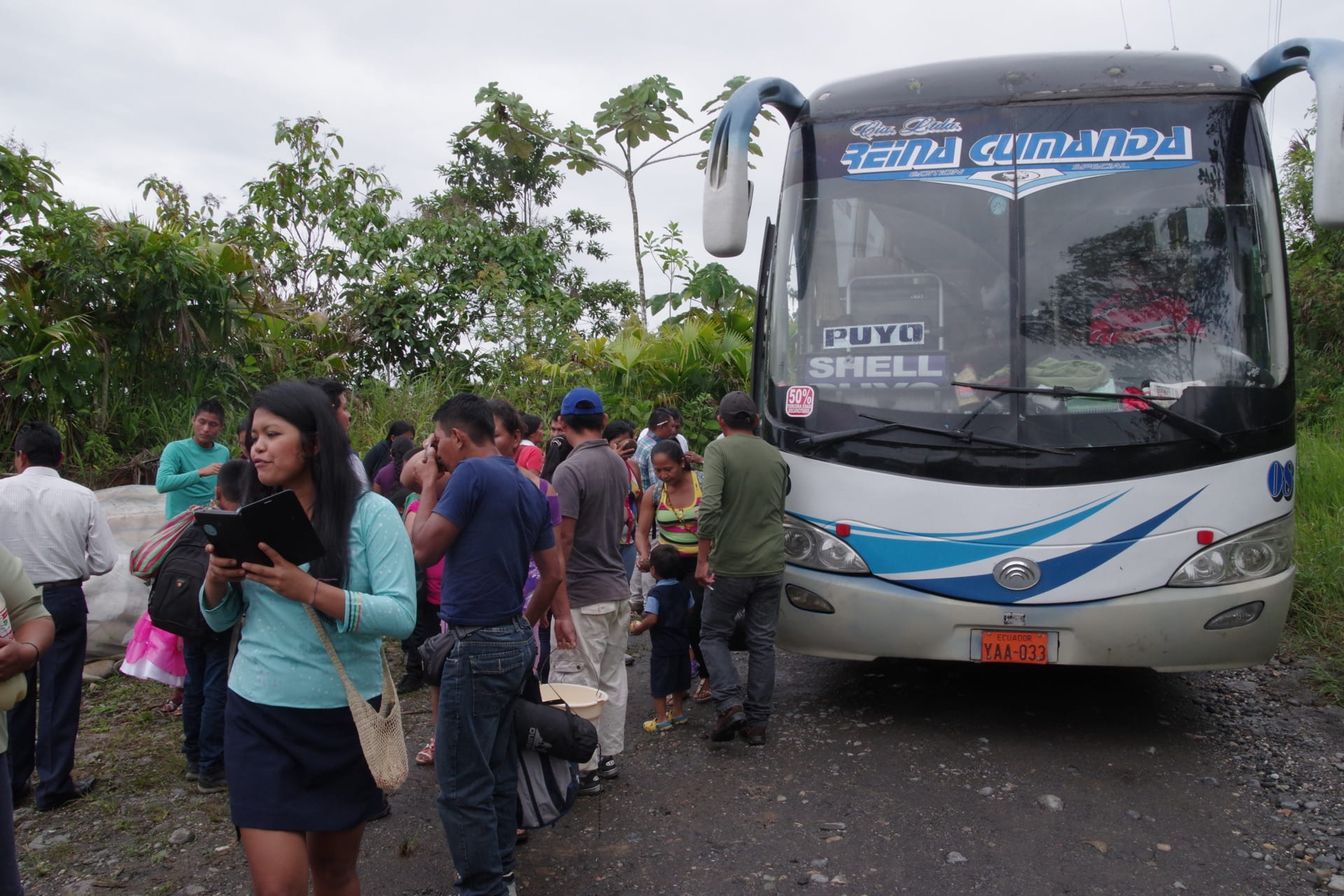
Visitors to the Wapuno ethnobotanical trail arrive by bus.
Although exchanges have always been crucial for the region, negative responses to government inroads can be traced back to the 15th-century Inca empire. The Incans constructed two long highways along coastal and highland regions from Quito to Argentina to carry their trade, military and government representatives across newly conquered territory. But, despite now-famous foothills sites like Peru’s Machu Picchu, there was little Inca entry into the Upper Amazon. Despite traditional, generally balanced, economic exchange between adjacent highland and upper rainforest populations, Inca invasion was repelled.
Such independence persisted even amidst the famous international Rubber Boom from the 1890s to the 1920s. Although rubber gatherers enslaved many locals in the lower Putumayo and Iquitos area, Ecuadorian and other Upper Amazon indigenous people largely balanced occasional rubber gathering with agriculture, fishing and hunting. Rubber gatherers did not significantly disrupt traditional lives, demand movement or eliminate indigenous territories. Things changed in the early 1970s when Brazil began its contentious Trans-Amazon Highway (BR-230). Amidst the government’s motto of opening “land without men for men without land,” hopefully linking regions of Brazil with Colombia, Peru and Ecuador, and encouraging colonization from Brazil’s northeast region, trucks and bulldozers entered to deforest and “develop” indigenous territories. Similarly inspired government highways soon worked their way into indigenous forests of Bolivia, Peru and Ecuador.
Entering Ecuador
In 1972, Texaco Oil Company plowed into Ecuador’s northeastern Oriente, cutting through indigenous territory and laying a pipeline from the Pacific port of Esmeraldas to newly opened Lago Agrio oil sites. Around the oil area and along the long pipeline, extensive lumbering and rapid colonization became extremely controversial due to extensive deforestation and pollution from sloppy well sites and leaky pipelines. Like the early Inca Road, indigenous residents saw no benefits from road construction or resource extraction. Though buses carried workers and colonists back and forth to the Andes, indigenous folk traveled locally by canoes or on foot. Some nearby groups, the Cofán, moved downriver while others, Secoya-Siona and Huaorani, sought to prevent invasion into their traditionally claimed but untitled territory.
At that time, the southern Oriente was comparatively uninvaded by roads and unpolluted by oil development. Nevertheless, colonists were arriving and the threat of invading roads, colonization and expanding oil or mineral extraction led regional Shuar and Kichwa indigenous to organize communally, followed by ethnic and interethnic federations across the Oriente. At the time, given domestic gardening, childcare and limited transportation, men were those most often visibly involved in political organization while women were active closer to home. Later transportation has diminished such gender differences, as will be seen through personal and communal lenses in Upper Napo/Pastaza community of Arajuno.
Traditional Concerns: Land Rights and Resource Access
At the turn of the 20th century, numerous indigenous settlements expanded along the upper banks of the Arajuno River. Residents walked from more crowded quiquin llacta, proper settlements near Tena and Archidona, to more forested sites called purina llacta. Such traditional, shifting residential patterns provided ample soil for slash-and-burn gardening, and claims for hunting and fishing rights in adjacent forests. While the settlements gradually formed group territories, acknowledged by neighboring agreements and spiritual ties, such land rights were not legally recognized, or even acknowledged, by the Ecuadorian government. Consequently, in July 1942, Shell Oil Company arrived, easily constructed a lengthy airstrip, brought in more than 200 workers and drilled test wells. Several merchants flew or walked in, opening stores adjacent to the Kichwa settlement.

A panoramic view of town
However, Ecuador and Shell ended their economic agreement and, between 1949 and 1950, Arajuno’s camp was abandoned by workers, leaving a few houses and the long airstrip. Shortly afterwards, the airstrip attracted Evangelical missionaries seeking proximity for conversion of the interior Huaorani. But five visiting missionaries were dramatically killed by Huaorani in 1956. Amidst the highly publicized oil exploration and murders, Arajuno’s indigenous families continued their traditional territorial patterns, creating a larger quiquin llacta, and opening purina llacta deeper in the interior forest. About four years later (1960), some earlier oil workers and others invited by them reentered and settled alongside the airport, hoping that a road into Arajuno would be constructed. But the road did not arrive and many of the colonists simply departed. Arajuno’s indigenous continued their traditional cultural and economic life.
In 1973, such indigenous land use patterns were challenged by Ecuador’s National Land Reform Laws. Applied throughout the Oriente without acknowledging indigenous land use and territorial claims, the government encouraged 50-hectare (125 acre) family plots with visible land use—particularly cattle raising. Aided by government loans, the remaining Arajuno colonists gradually opened such land holdings close to the airstrip. They were hoping that a road would soon connect them to the regional capital Puyo. Some Kichwa occupied adjacent plots near the airstrip, while continuing travel to their purina llacta. As structured, visible land use rose near the airstrip, tensions increased as colonists sought local political control and economic expansion, which they hoped would increase through an access road.
Following ethnic views at the time, colonists regarded most local indigenous as uneducated, largely monolingual and disinterested in economic growth. Equally troubling, neither the government nor the colonists accepted the historic Kichwa understanding of territory, land use, or resource preservation. Though Kichwa remained strongly focused on subsistence economy and forest life, schooling increased when two missionary-supported elementary schools were set up, as local missionary attention shifted from Huaorani to locals (Adjacent Huaorani were assisted and pacified by female relatives of those previously killed…See Through Gates of Splendor, by widowed Elisabeth Elliot). Some Kichwa men occasionally travelled to coastal plantations for work, thus increasing their knowledge of Spanish. But high schools (colegios) required travel to and residence in Tena or Puyo and university education was more distant and barely considered. Few young children left Arajuno until the 1970s.
Shifting Ethnicity
There were a few notable exceptions. The son of one early arrival, Vicente Andi, walked out of Arajuno to join the national army. But during some protests at the Presidential Place, he was seriously wounded and returned to rural life In Arajuno. Later in the 1970’s, an elder Kichwa, Alonso Andi, killed a giant Anaconda, sold the snakeskin to a shoe manufacturer in Quito, and used the payment to enroll his son, Delfin Andi, at the Catholic high school in Tena. Delfin left, graduated, and returned to become an elementary teacher in a neighboring Huaorani community, where he married a local and gradually became a bilingual political leader as the Huaorani worked to prevent expanding oil development in their territory.
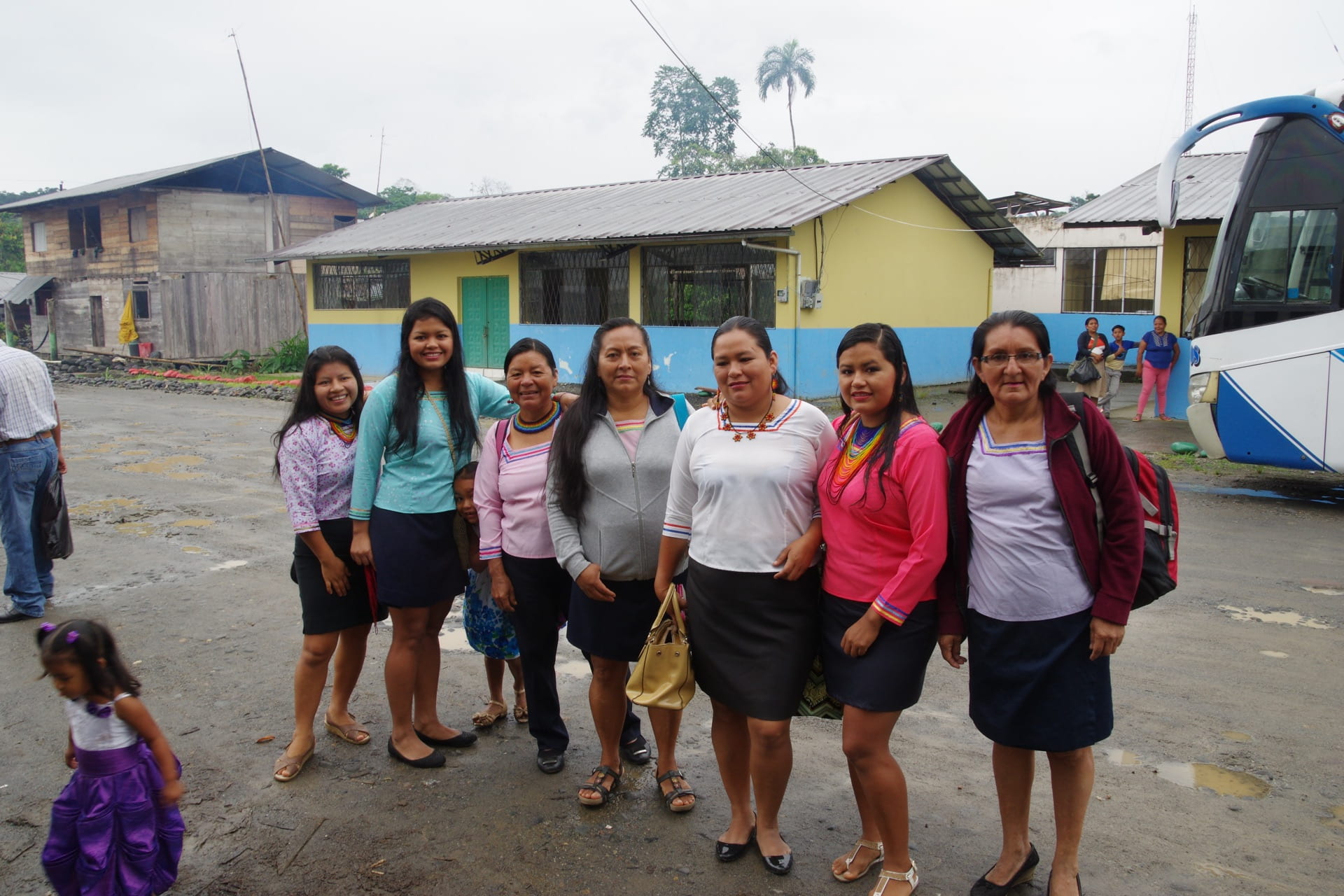
The López family with a bus in the background
Perhaps the most noticeable, and rare, schooling departures were women. Delfin’s younger sister, Martha, later walked thirteen hours south to attend a regional teaching institute in Canelos, and then traveled to the Andes for a teaching license in Riobamba. She now leads bilingual education classes in Arajuno. Earlier, Margarita Lopéz, the daughter of a well-known local leader and powerful Kichwa yachaj (shaman), Pablo Lopéz, was sent off, at age 14, to a Catholic school in distant Guayaquil, assuming that she would remain safely and comfortably embedded in the Catholic nunnery. Margarita, however, disagreed, traveled to the same Tena colegio as Delfin, and then became a teacher in Arajuno, strongly encouraging other women’s education. She later married a Tena-area Kichwa, Cesar Cerda, and both became strongly involved in the rising Amazonian indigenous movements. At the time, education required much foot travel in and out of Arajuno, and long absences due to distance, but none of the few young men or women expected incoming roads. That changed.
At the time, to the south the Shuar Federation, which had emerged earlier in the 1960s, worked with similarly inspired young indigenous in Puyo, helping to create the Organization of Indigenous Communities of Pastaza, OPIP. Shuar later worked with young Kichwa in the Tena-Archidona area, helping them create the Federation of Indigenous Organizations of Napo, FOIN. These regional ethnic groups linked in the late 1970s and, in 1980, established the multi-ethnic Amazonian confederation, CONFENIAE. Newly educated youth sparked much of this growth.
In 1979, several young Arajuno indigenous men walked for a while to Puyo or traveled downriver to Tena, where they were impressed with the regional leaders, and returned to create Arajuno’s ethnic federation, the Association of Indigenous Communities of Arajuno, ACIA. Given the clear political neglect of indigenous land interests by local and regional colonist officials, and national efforts by President Leon Febres Cordero (1984) to promote individual 50-hecate lots, the main goal of ACIA was to secure the defense of their natural resources and ancestral territories. They self-demarcated and mapped their earlier purina llacta, establishing ecological reserves within many of their settlements. Noting the increased indigenous political and educational growth, as well the absence of an inroad, several colonists sold or simply abandoned their Arajuno land plots.
As ACIA sought local government control at the time, it was largely through male leadership because some men spoke Spanish and traveled overland regularly. Women participated in all community meetings, but rarely traveled or clearly led due to childcare and limited education. However, Martha’s and Margarita’s teaching and political involvement soon encouraged increased female involvement. Notably, in 1984, Margarita sparked strong women’s actions when violence threatened Arajuno. Government officials and topographers flew in by plane to increase individual 50-hecare plots in interior communal territories. But, when government officials and topographers landed, ACIA leaders surrounded the plane and carried the workers and their equipment to their communal headquarters. Soon, the few Arajuno colonists radioed the national military, claiming that heavily armed indigenous had captured the topographers. Shortly thereafter, armed military planes arrived.

Margarita Lopez, beside her husband , Cesar Cerda, lecturing to Andean visitors.
Concerned with potential violence, Margarita and an aunt gathered numerous women, dressed in what Margarita described as a peaceful clothing, and stood alongside the airstrip when the military arrived. After a bit shouting, the women explained the problem and led the military to ACIA’s headquarters. There, the colonel entered and negotiated peacefully with ACIA’s leaders. Before the soldiers calmly departed, the women asked for and received praise. They not only served as buffers for the men, but they also displayed intelligence and leadership in the meetings.
Such action inspired more future female participation. Amidst local indigenous political rise, similar concerns over land rights rose as corporate oil interests expanded into neighboring Villano and Sarayacu. A dramatic series of events and marches took place in 1992. (While the movements led to several broad government land agreements, including Arajuno, clear land rights, particularly regarding access to resources remained uncertain, provoking several international court decisions. During these broad territorial shifts, Arajuno’s status grew from a parroquia village to a large regional canton in 1996.
The Road Arrives
Canton leaders soon requested that a road being constructed toward a regional oil pumping station be extended northward to Arajuno. Carretera Triunfo Arajuno arrived on April 9, 2000. Although logging occurred all along the entry road, as well as some interior sites, and new businesses flooded in…hardware store, printing shop, internet café and a mechanic and gas station to service the newly arrived cars, motorcycles and buses, indigenous participation and influence in municipal government grew. Creating new positions that connect Arajuno to mainstream Ecuadorian politics, the municipal government now coexists alongside ACIA, and smaller ethnic organizations in Arajuno, illustrating Ecuador’s pluri-national system, and reflecting earlier land and environmental priorities.
To expand understanding, the road now opens and illustrates ACIA’s priorities to protect and secure biodiversity. Environmentally focused national and international students, not simply land-clearing colonists or marketing agents, now travel regularly to Puka Rumi, an environmental reserve established by Margarita and Cesar amidst Pablo Lopéz’s old purina llacta at the foot of Pasu Urcu. Student arrivals are not simply visitors. Many directly assist and publicize the previously isolated environmental reserve. Deeper into the forest, many old but now titled purina llacta communities also invite students to flow in, visit, study and assist their work to preserve large, richly forested wildlife areas.

Bus visitors
Meanwhile, buses moving in and out have altered the roles of many local young women. Previously, they worked mainly in family agriculture, chakras. As the economic and political spheres changed, the road sparked an outflux of young people, easily traveling by bus to high schools and universities. Not only was such education previously difficult to access, but the lack of job opportunities in Arajuno provided little incentive. New opportunities not only inspired many indigenous youth to leave, attend colegio and university, but also to return, to be active in changing local educational, economic and political spheres. Colegio and university study, now prioritized by many families, are becoming the norm rather than the exception.
The road has subsequently expanded women’s local roles. Earlier women’s primary roles—chakra workers and family caregivers—meant that only a few, with supportive families like those of Margarita and Martha, left Arajuno to study and work. The new road encourages many women to leave and study while also continuing to help maintain the chakra and care for the family… and increasing their participation in local politics. Many such transportation shuttling women have become a driving force in ACIA’s political push to maintain Kichwa identity, rights and territory.
To illustrate, several of the old shaman/leader Pablo’s descendants have become particularly noticeable bus riders and broad familiar faces. The road has inspired bright and enthusiastic female leaders to leave and return easily to Arajuno, armed with degrees, to involve themselves not only economically, but also politically, in important new movements.
As Margarita’s older brother, Dionisio, became a lawyer and local historian, her younger sister, Isabel, easily received an advanced teaching certificate in Puyo after the road arrived. Earlier, she, like Delfin’s younger sister Martha, studied in Canelos, which required much walking and time away from home. After the road arrived, Isabel bussed back and forth to new Puyo university classes with ease, while also raising a young family. Every weekend she took classes or exams after a week in Arajuno tending both her family and chakra. Now Isabel is the director of the elementary school in Arajuno Escuela Gabriel Lopez, named for her grandfather, an early settler. Teaching provides her with a stable and prestigious life in Arajuno and, perhaps more important, inspired her children to head off for advanced education. They, following Isabel, are heavily involved in ACIA politics, attend meetings, speak as leaders, and encourage traditional culture.
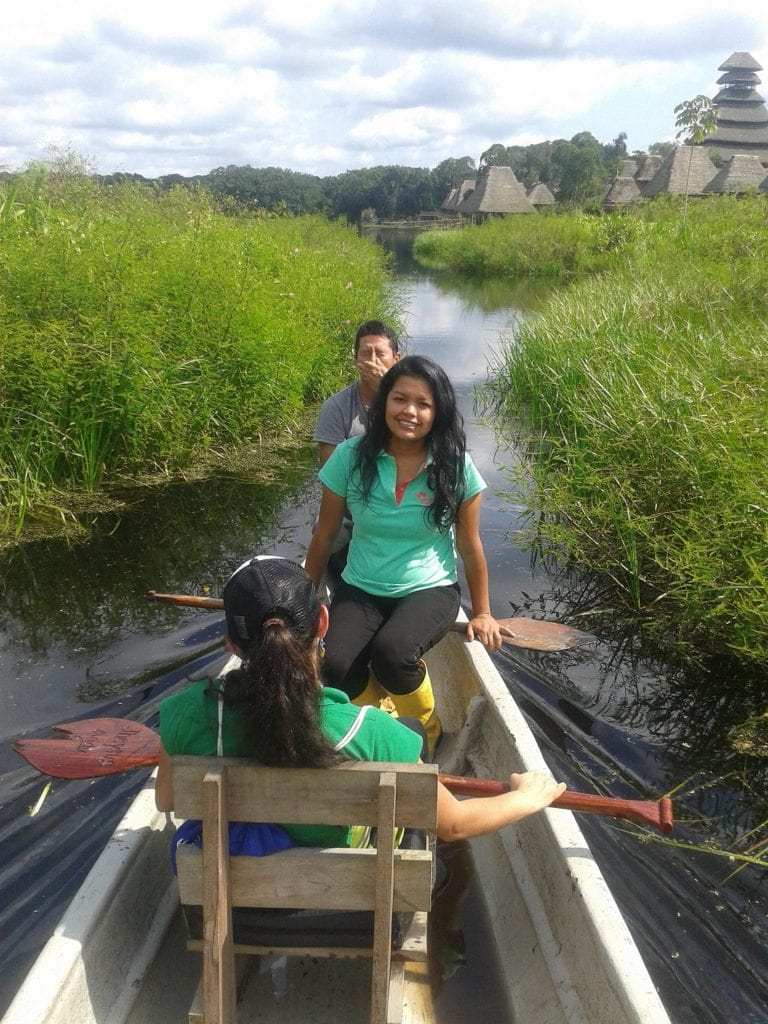
Local landscape.
Isabel’s daughter, Jessica, after colegio in Puyo, bussed from Arajuno to study environmental and cultural tourism at the Universidad Estatal Amazonica in Puyo during the week, returning to Arajuno on weekends to join her family and help in the chakra. After graduation, she worked in such tourism around Puyo, still shuttling home on weekends. In 2020 Jessica began more distant tourism, linked on the lower Napo to the Federation of Native Communities of the Ecuadorian Amazon (FCUNAE) and working in the rich and much-visited Yasuni National Park. After occasionally returning to ACIA meetings, she returned to raise her new-born son amidst her family and continued her involvement in ACIA, participating in ACIA events, and using her schooling to promote Kichwa cultural, environmental and political goals.
Jessica’s sister, Diana, likewise graduated from high school and helped at home by going back and forth to study in Puyo. She later received a scholarship to attend the Universidad San Francisco in Quito and graduated with a degree in finance. With it she returned to Arajuno to work in the education sector of municipal government offices. Inspired by her mother and other politically active relatives, Diana linked herself closely to ACIA, advancing political and environmental concerns. While she worked with her mother to open a small sewing business where they make traditional local clothing in Arajuno, Diana’s main focus has expanded through joint work with her new husband Luis Canelos, a similarly active and highly educated indigenous leader. Among a range of activities, they work closely with a strong Puyo-based environmental and conservation organization, Fundación Sacha Warmi.
In 2021, Diana became the first woman elected president of ACIA, the highest role in the organization. So, Diana not only participates in, but leads, increasing local and regional political movements, defending Kichwa territory by also hosting related events amidst the interior purina llacta communities and representing ACIA in environmental and political meetings across the Oriente, where similarly educated, high level women from Kichwa communities such as Sarayacu (e.g., Patricia Gualinga, now well-known internationally) are increasingly active and visible. Traveling easily, they work to link their traditional culture to contemporary efforts to secure land and resources rights that ensure biodiversity.

Visitors to the Wapuno ethnobotanical trail listen to guide.
Meanwhile, quite differently and dramatically, women in ACIA have activated cultural events that remind and reinforce Kichwa pride and heritage amidst dramatic economic and political changes. A breakfast that was once part of daily spiritual life among Kichwa families has been formalized into community events… “huayusa upina”… where townspeople gather monthly, at 3 a.m., to share huayusa tea, traditionally understood to strengthen spiritual ties for hunting and gardening. The current events, inspired by younger women, now involve political speeches as well as large shared traditional breakfasts they prepare.
With current educational skills and assisted by transportation, Kichwa women now play large and leading roles in a growing political landscape, while imaginatively crafting cultural events drawn from historically clear Kichwa women’s roles and expertise. As women lead huayusa upina events, they do not simply or passively host. They illustrate their active political lives. Quite simply and tangentially, significant political and cultural changes promoted by Ecuadorian indigenous peoples, particularly women, expanded when buses shifted “transportation” from a difficult occasional walk to a comfortable regular ride. While vehicles have radically refocused women’s sense of self, they have, ironically but positively, assisted evolving broad Kichwa political efforts to elevate environmental and territorial concerns and related rights in a traditional multicultural, and now formally trilingual, nation.
Fall 2021, Volume XXI, Number 1
Ted Macdonald is a Lecturer in Social Studies and Faculty Affiliate at DRCLAS, Harvard University. He has worked directly on Latin American indigenous rights issues and cases since 1980. Currently and in collaboration with Kichwa Indian community leaders, he is preparing an ethnographic history of territorial rights and self-determination in the Ecuadorian Amazon.
Megan Monteleone, Harvard College 2016, is in her second year of law school at Georgetown University Law Center where she is studying international law and continuing to work on the advancement of indigenous rights. Her Social Studies thesis on women’s involvement in the indigenous rights movement in the Ecuadorian Amazon was awarded the Hammond Prize for best Harvard undergraduate thesis on Latin America.
Related Articles
Editor’s Letter: Transportation
Bridges. Highways. Tunnels. Buses. Trains. Subways. Transmilenio. Transcable. When I first started working on this issue of ReVista on Transportation (Volume XXI, No. I), I imagined transportation as infrastructure.
Modernity in Black and White
For years, one of my favorite pieces in the Museo de Arte Latinoamericano de Buenos Aires (MALBA) was the iconic Abaporu (1928), by Brazilian artist Tarsila do Amaral: a canvas…
Transportation Itself Does Not Build Urban Structures
English + Español
Fina Rojas lives in the 19 de Abril at Petare, the densest and one of the largest self-produced neighborhoods in Latin America. Most researchers and policymakers define self-produced neighborhoods as “informal settlements.” However, these settlements occur from…

